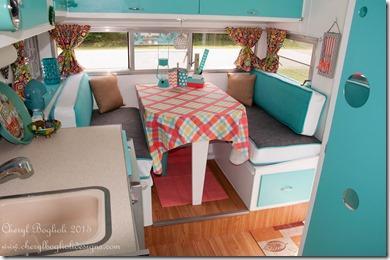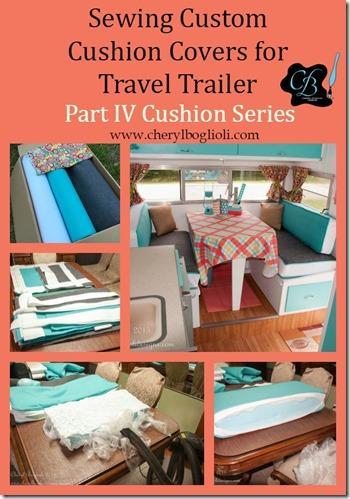 I searched high and low for the perfect fabric to create cushion covers with. I wanted something that would hold up well in a travel trailer and be comfortable enough to sit on and sleep on. I also wanted it to work with my colors and theme design overall for Glinda. As I walked by the Kunin Group booth at the Craft & Hobby show this January, I noticed a gorgeous child coat in aqua. One of my designer friends, Debra Quartermain, was working in the Kunin Group booth and I mentioned how pretty that color was. We started talking about Glinda and how she was coming along and Debra asked if I had considered using felt for my cushion fabric. That is one thing I had not even considered. After learning more about this fabulous new Eco-fi Plus Premium Felt with Kunin, we thought it would be the perfect fabric for a travel trailer. Why?
I searched high and low for the perfect fabric to create cushion covers with. I wanted something that would hold up well in a travel trailer and be comfortable enough to sit on and sleep on. I also wanted it to work with my colors and theme design overall for Glinda. As I walked by the Kunin Group booth at the Craft & Hobby show this January, I noticed a gorgeous child coat in aqua. One of my designer friends, Debra Quartermain, was working in the Kunin Group booth and I mentioned how pretty that color was. We started talking about Glinda and how she was coming along and Debra asked if I had considered using felt for my cushion fabric. That is one thing I had not even considered. After learning more about this fabulous new Eco-fi Plus Premium Felt with Kunin, we thought it would be the perfect fabric for a travel trailer. Why?

Let me list the reasons why this was the perfect choice:
- gorgeous colors
- soft fabric with a great texture too (I love texture)
- it is eco-friendly – made from recycled water bottles
- it resists
- mold
- mildew
- odors
- it does not fray
- don’t have to worry about right side or wrong side of fabric
I can’t think of anything better for a travel trailer. We decided to give it a go and make some cushion covers with it.
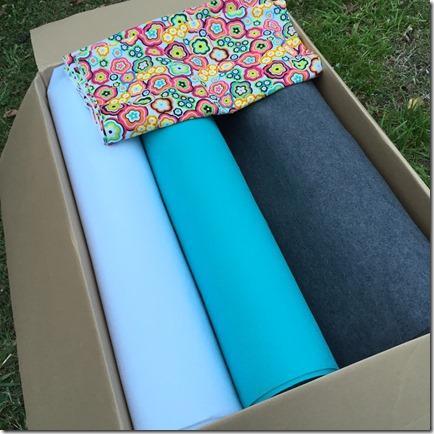
Kunin Group graciously sent me a bolt of white, aqua and smoke to design with. Needless to say, I’ll have some leftovers to create some more fabulous projects in the future. I already have a few I’m working on and a few in mind. And you can see I found the perfect fabric for my curtains. By using solids on the cushions, I was able to go groovy wild with the curtain fabric!
I estimated what I would need to get started on the cushions. I also knew that my longest cut would be 80’ for the back gaucho cushions (additional post coming soon), so I cut first cuts at 2.5 yards each. This fabric also gets softer the more you wash and wear it, so I washed and dried each cut of fabric three times. I experienced virtually no shrinkage with washing and then drying in the dryer. The aqua still came out softer than the others. The smoke color was the least soft, but still softened up.
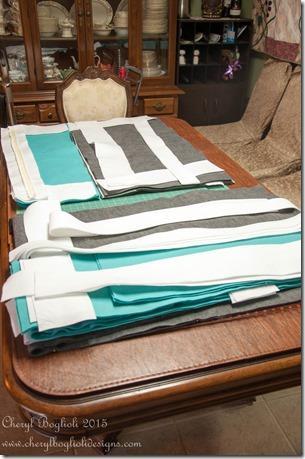
Using measurements from my cushions that we have already cut and wrapped, I cut out fabric for all of my cushions. I needed two base/seat cushions for the dinette and two back rests. For the gaucho, I was going to need one large seat base and two back rests. Depending on your cushions, your dimensions will be different than mine.
My original dinette cushions were 39×18. The back went all the way down to push the seat forward. This caused the seat to push out when sitting, so I altered my dimensions. My dimensions became 39×22 for the seats and 39×12 – all 6” thick. To make my cushions tight and fluffy, I cut the boxing pieces a little shorter than actual cushion height. This compresses the cushion and creates a full cushion. This is what I cut out.
Per each Base/Seat
2 ea smoke – 40 x 23 (top and bottom)
1 ea white – 40 x 5.5 (front boxing)
2 ea 2 white 3 x 5.5 (side boxing)
2 ea white 40 x 3.25 (back boxing pieces to sew with zipper)
Per each Back rest
2 ea aqua – 40 x 13 (top and bottom)
1 ea white – 40 x 5.5 (front boxing)
2 ea white 13 x 5.5 (side boxing)
2 ea white 40 x 3.25 (back boxing pieces to sew with zipper)
You can search for different ways to sew a hidden zipper into your boxing pieces. My basic tutorial for sewing hidden zipper in boxing was on yesterday’s post Zippers & Piping.
After sewing all of your boxing pieces together, it is time to assemble your cushion covers.
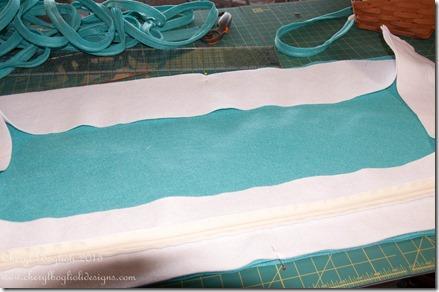
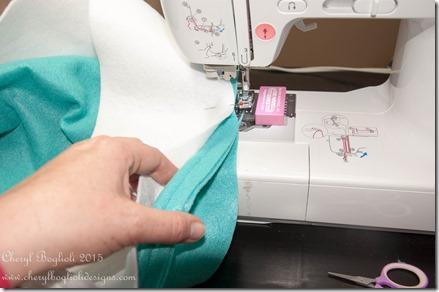
#2. Start adding piping halfway down an edge. Chose a side or the rear to help hide where the piping will join. I continued to use a zipper foot here to ride along the piping. You could use a piping foot if you have one. Start sewing all layers with 1/2” seam allowance about 3-4 inches from where you started the piping. Sew slowly. This is a lot of bulk going through the machine at once. I ended up using a Jeans needle and take your time.
#3. At corner, snip your piping seam about 1/2 before end of side. Leaving needle in down position, rotate cushion about 90 degrees and continue sewing corner. You may have to compensate for bulk and piping here. I could not get sharp corners but needed to have more of a rounded corner as tight as I could turn it b/c of the bulky piping. Again, take your time and sew slowly. You may have to hand crank your sewing machine around the corner. Don’t worry, I’ll show you how to make a neat sharp corner in our gaucho cushions later this week when I didn’t use the piping.
#4. Continue sewing the piping in between boxing and cushion top (or bottom) making sure to snip and carefully turn each corner.
When you get to back to where you started, you will need to trim and join your binding. To do so:
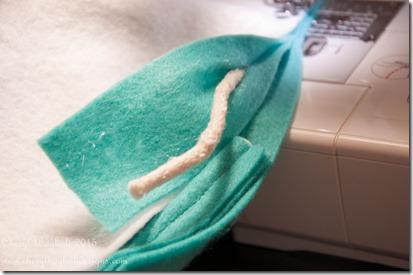
#5. Cut binding about 3-4” longer than where you started. Open seam of tail about 3”. Align the cording and cut the tail cording to abut with the beginning cording.
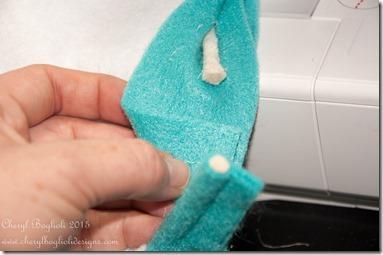
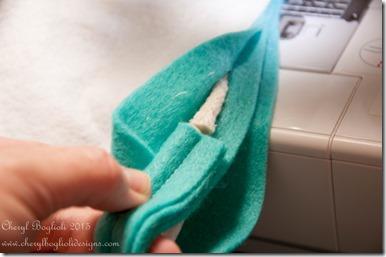
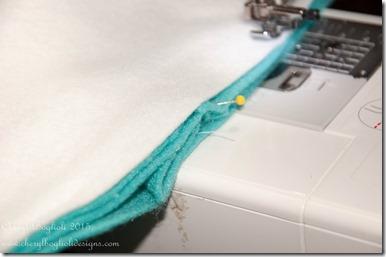
#7. Pin all this in place back into your cushion sandwich and sew. I pulled the edges of binding out just a bit so it would not be loose when open. This is one side of the cushion complete.
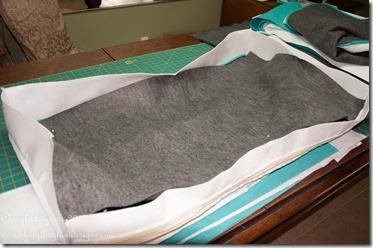
#8. Pin the other side of the cushion to the other ends of the boxing. (don’t let color change fool you. I was taking pictures throughout this process and culled through to find the better photos for examples)
#9. Repeat steps #2-#8 to sew boxing, cushion bottom, and piping together. TIP: Before you sew the whole thing shut, partially unzip the zipper.
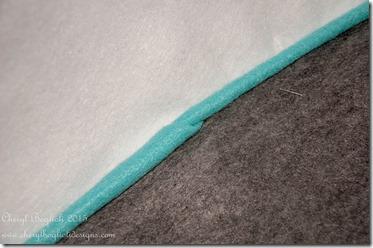
#10. Now turn your cushion right side out. Your piping joints will be neat and your piping will be between boxing and tops and bottoms.
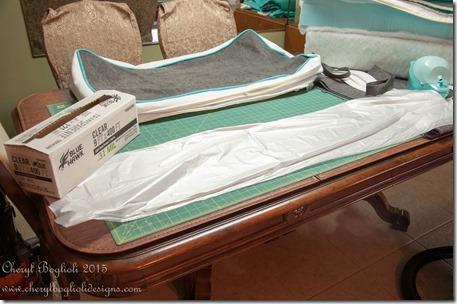
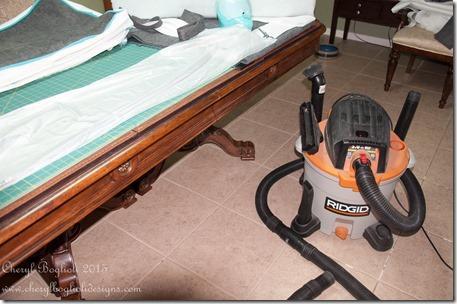
You’ll notice I have a roll of plastic. This came in handy for painting and for my cushions. The trick to getting that fluffy custom cut and wrapped cushion stuffed into your snug covers is going to take plastic film and a shop vac. Trust me. This is so worth it. You could probably use a really good vacuum cleaner.
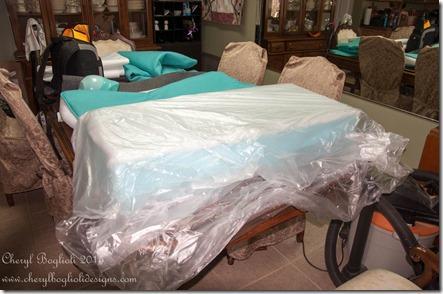
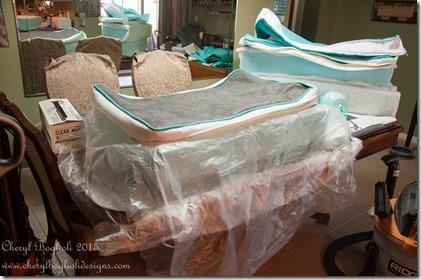
Place hose of shop vac on the back side of the foam that is not wrapped in batting, making sure to wrap plastic around shop vac hose as well. Turn on the shop vac and watch the magic happen. Keep tucking any plastic around the edges.


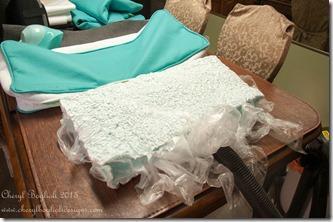
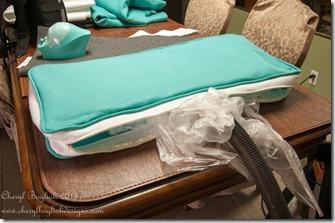
While the shop vac is still running, you can take your hand off the hose and place the cushion into the cover. Push the cushion all the way to the front and try to center it as well as possible. (sorry guys, I didn’t have a tripod at the house to take a video of this process – tripod was at the studio).
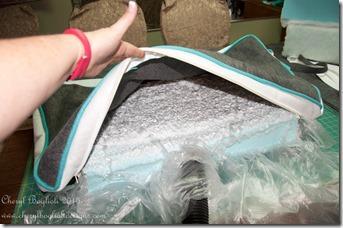
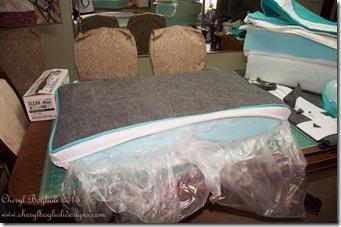
When you turn the shop vac off, the foam will quickly start filling and fluffing. Remove all hand jewelry and now slide your in between cushion and cover and pull the plastic out. You will need to rip it in places, but this plastic film is thin and rips easily.
You could leave this plastic if you wanted to waterproof your cushions, but it might make it noisy when sitting on it.
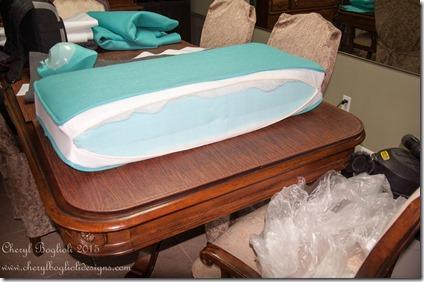
Complete this entire process for all of your cushions. I now have custom cut, wrapped, piped, and sewn cushions with removable covers. Glinda is looking so nice. I can’t wait to share her with you after the Big Reveal in historic downtown Fort Pierce on Sunday March 29th. You can find the event invite on my Cheryl Boglioli Designs Facebook Page. Come join us. I’ll share how I created the gaucho bed in a few days and will show you to to get crisp corners on your boxed edges.
